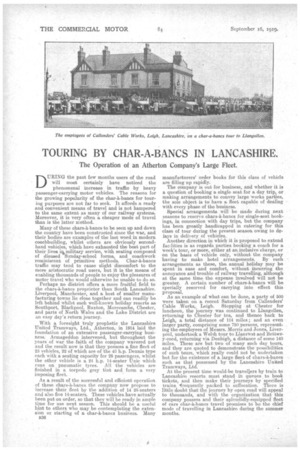TOURING BY CHAR-A-BANCS IN LANCASHIRE.
Page 14

If you've noticed an error in this article please click here to report it so we can fix it.
The Operation of an Atherton Company's Large Fleet.
DLIKING the past few months users of the road will most certainly have noticed . the phenomenal increase in traffic by heavy passenger-carrying motor vehicles. The reasons for the growing popularity of the char-a-banns for touring purposes are not far to seek. It affords a ready and convenient means of travel and is not hampered to the same extent as many of our railway systems. Moreover, it is very often a cheaper mode of travel than is the latter method..
Many of these chars-a-banes to be seen up and down the country have been constructed since the war, and. their bodies are examples of the last word in modern coachbuilding, whilst others are obviously secondhand vehicles, which have exhausted the beet part of their lives 4 military service, with seating composed' of disused Sunday-school forms, and coachwork reminiscent of pruiaitive methods. Char-h-banes traffic may tend to cause slight discomfort to the more aristocratic road users, but it is the means of enabling thousands of people to enjoy the pleasures of motor travel who would otherwise be unable to do so.
Perhaps no district offers a more fruitful field to the ehars-k-bancs proprietor than South Lancashire. Liverpool, Manchester, and a. host of smaller mania faeturing towns lie close together and can readily be left behind whilst such well-known holiday resorts ae Southport, Blackpool, Buxton, Morecambe, Chester, and parts of North Wales and the Lake District are an easy day's return journey.
With a foresight truly prophetic the Lancashire United Tramways, Ltd., Atherton,in 1914 laid the foundation of an extensive passenger-carrying business. Armageddon intervened, but throughout the years of war the faith of the company wavered not and the result now is.that they possess a fine fleet of 23 vehicles, 22 of which are of the 40 h.p. Dennis type each with a seating capacity for 28 passengers, whilst
i the other vehicle s a 24 b.p. 14-seater tInic which runs on pneumatic tyres. All the vehicles are finished in a torpedo grey tint and form a. very imposing fleet.
As a result of the successful and efficient operation of these chars-a-banes the company now propose to increase their fleet by the addition of 14 28-seaters and also five 14-seaters. These vehicles have actually been put on order, so that they will be ready in ample Lime for use next season. This should be a useful hint to others who may be contemplating the extension or starting of a thar-a-bancs business. Many manufacturers' order books for this class of vehicle are filling up rapidly. The company is out for business, and whether it is a question of booking a single seat for a day trip, or making arrangements to convey large works parties, the sole abject is to have a fleet capable of dealing with every phase of the business. Special arrangements will be made during next seasons to reserve chars-a-bancs for single-seat bookings, in connection with day trips, but the company has been greatly handicapped in catering for this class of tour during the present season owing to delays in delivery of vehicles. Another direction in which it is proposed to extend
• fae,lities is as regards parties booking a coach for a week's tour, or more, either at an inclusive charge, or on the basis of vehicle only, without the company having to make hotel arrangements. By such arrangements as these, the annual holiday may ho spent in case and comfort, without incurring the annoyance and trouble of railway tra,velling, although at the same time the expense involved will not be greater. A certain number of chars-a-banns will be specially reserved for carrying into effect this proposal. As an example of what can be alone, a party of 500 were taken on a recent Saturday from Callenders' Cable Works, Leigh. Stopping at Chester for luncheon, the journey was continued to Llangollen, returning to Chester for tea, and thence back to Leigh, a total distance of 114 miles ; and an even larger party, comprising some 750 persons, representing the employees of Messrs. Morris and Jones, Liverpool, undertook a Welsh tour to Llanrwst and Bettwuy-caed, returning via Denbigh, a distance of some 140 miles. These are but two of many such day tours, and they are quoted to demonstrate the 'possibilities of such tours, which really could not be undertaken but for the existence of a, large fleet of chars-a-banes such as that possessed by the Lancashire United Tramways, Ltd. At the present time would-be travellers by train to Lancashire resorts must stand in queues to book tickets, and then make their journeys by specified trains. sfrequentIy packed to suffocation. There is little doubt that the journey by open road will appeal to thousands, and with the organization that this company possess and their splendidly-equipped fleet of ears char4-banes travel promises to be the chief mode of travelling in Lancashire during the summer months.
























